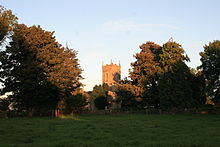Clonard Abbey


Clonard Abbey(Irish:Mainistir Chluain Ioraird,meaning "Erard's Meadow" ) was an earlymedievalmonasterysituated on theRiver BoyneinClonard,County Meath,Ireland.
Early history
[edit]The monastery was founded in about520bySaint Finnian,who initially constructed a single cell at the site.[1]The original site may have been at nearby Ard Relec.[2]According to medieval chronicles, Finnian was led to the site by anangelwho told him that it would be the place of hisresurrection.He was well-travelled, and based his monastery on the training he received at Tours and Llancarfan.[3]Finnian was buried on the site after his death in about549.During the sixth century, some of the most significant names in the history ofIrish Christianity(who would go on to be known as theTwelve Apostles of Ireland) studied at the monastery.[citation needed]
Clonard was situated on theEsker Riada,Ireland's main east-west road in early medieval times, adding to its prominence. However, it was also on the boundary between the kingdoms ofLeinsterandMeaththat were occasionally at war.[citation needed]
From the eighth century onwards, Clonard came under the control of various rival political dynasties,[2]and by the mid-ninth century, it was the leading church of the Irish midlands. Theabbot of Clonardled the clergy of the midlands in the same fashion that the abbot ofArmaghled those in the north.[4]During its heyday, a hymn written in Finnian's honour claimed that the monastery's school housed 3,000 pupils receiving religious instruction at any given time.[5]
A great part of the abbey erected by St. Finian was burnt in 764. Like many monastic sites in Ireland, Clonard suffered heavy losses under theVikingraids of the ninth through eleventh centuries. In the year 838 the Danes destroyed it and put the clergy to the sword. They returned again in 888.[6]In 939, Ceallachan, King of Cashel, assisted by the Danes of Waterford, plundered the abbey. In 970, Donell, son of Murcha, pillaged and burnt Clonard.[7]
As a diocese
[edit]From theSynod of Ráth Breasail(1111), it was the centre of the newseeof Clonard, to which, were added the bishoprics of Trim, Ardbraccan, Dunshaughlin, and Slane, indicating its importance at the time. This was confirmed at theSynod of Kellsin 1152. In 1113, Connor, King of Munster, plundered Meath and forcibly carried off the riches of the whole province, which had been lodged for safety in the abbey church.[7]A great part of the abbey, and all the library, was consumed by an accidental fire in 1143. The abbey and town were despoiled and burnt in 1170, by M'Murcha, aided by Earl Strongbow and the English, and having been afterwards rebuilt, they suffered a similar fate in the year 1175.[6]That same year, Walter, son of Hugh de Lacy, erected, probably on the ruins of the ancient abbey, an Augustinian monastery. Clonard fell into decline during the twelfth century, and in1202,theNormanbishop de Rochfort transferred the see from Clonard toTrimin the newDiocese of Meath.[2]
Very little remains of the site today. From the air, the outlines of some wall boundaries and otherearthworksare visible.
Annalistic references
[edit]SeeAnnals of Inisfallen(AI)
- AI748a Kl. Repose of Mo-Dímóc of Cluain Iraird.
- AI870.1 Kl. Repose of Suairlech of In tEidnén, abbot of Cluain Iraird.
- AI926.1 Kl. Repose of Colmán son of Ailill abbot ofCluain Moccu Nóisand Cluain Iraird.
- AI954.2 Repose of Dub Inse, learned bishop of Ireland, and of Cellachán, king ofCaisel,and of Éladach the learned, abbot ofRos Ailithir,and of Uarach, bishop ofImlech Ibuir,and of Célechair, abbot ofCluain Moccu Nóisand Cluain Iraird, and of Cormac Ua Maíl Shluaig, learned sage ofMumu,and of Lugaid Ua Maíl Shempail, abbot of Domnach Pátraic, and of Cenn Faelad son of Suibne, anchorite ofCluain Ferta Brénainn.
References
[edit]- ^
 Herbermann, Charles, ed. (1913)."School of Clonard".Catholic Encyclopedia.New York: Robert Appleton Company.
Herbermann, Charles, ed. (1913)."School of Clonard".Catholic Encyclopedia.New York: Robert Appleton Company.
- ^abcLalor, Brian (2003).The Encyclopedia of Ireland.Yale University Press.p. 212.ISBN0-300-09442-6.
- ^""Clonard Abbey", Monastic Ireland ".Archived fromthe originalon 3 March 2016.Retrieved18 May2014.
- ^Charles-Edwards, T.M. (2006).The Chronicle of Ireland.Liverpool University Press.pp. 9–10.ISBN0-85323-959-2.
- ^Colatur a fidelibusfromBrev. ms. Hibernicum saec. 15. Cod. Oxonien. Miscell. Liturg. 215.This hymn is reprinted inDreves, G.M. (1895).Analecta Hymnica Medii Aevi,vol.19.Leipzig: O.R.Reisland. p. 132.
- ^ab"A Relic of Clonard, County Meath",Dublin Illustrated Journal,Volume 1, Number 35, 3 May 1862
- ^abLewis, Samuel. "Clonard, A Post Town and Parish",A Topographical Dictionary of Ireland,S. Lewis & Co., London, 1837
